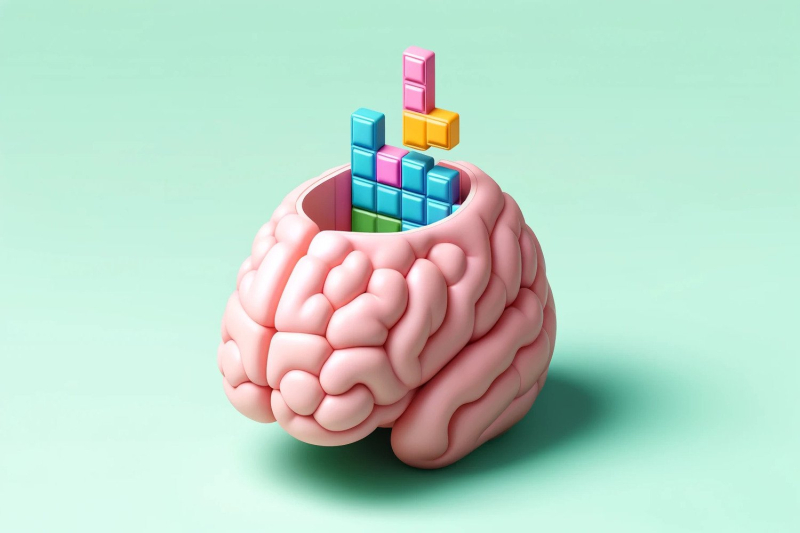
© Image generated by DALL-E AI for Presse-Citron
Designed by Soviet engineer Aleksey Pajitnov in 1984, the game Tetris was a mainstay of modern arcade games and is still played by many people around the world. A simple interface, a principle that is just as simple and colorful blocks that have conquered the hearts of many players over several decades. However, it turns out that its potential is not just for fun.
Already in 2009, researchers from Oxford looked into this game and published this study, led by Emily A. Holmes. This proved that playing Tetris would disrupt the brain's ability to memorize information and help reduce the negative effects of trauma. This little game could then reduce the visual intrusions that occur after traumatic events and could offer an interesting alternative therapeutic solution in the treatment of post-traumatic stress syndrome (PTSD).
PTSD is defined by John W. Barnhill in MSD Manuals as “ a disabling disorder that develops after exposure to a traumatic event. It is characterized by intrusive thoughts, nightmares and flashbacks; avoidance of reminders of the trauma; negative cognition and moods; hypervigilance and sleep disorders “.
The process of “cognitive vaccination”
The 2009 study demonstrated that the The use of Tetris as a therapeutic tool is based in part on its ability to overload the brain's visual memory system.. This would then occupy the latter enough to interfere with the way traumatic memories are normally recorded.
By overloading this system, the formation of memories intrusives therefore find themselves disturbed. Potentially, the frequency or intensity of involuntary memories of the trauma that may suddenly occur in a person suffering from PTSD could thus reduce.
This process, called “’ ;nbsp;cognitive vaccination » by the researchers responsible for the study, would be triggered if the person exposed to a traumatic event is able to play Tetris within a fairly short period of time after it. The ideal window would be around six hours. This first study opened the way to other, more in-depth research.
Studies and observations
A 2017 review (Visuospatial game in PTSD symptoms alleviation: intervention overview and clinical studies results ) brought together several clinical studies that extended the analysis to real-life situations. These included participants who had experienced traumatic events (war, road accidents, etc.) and concluded that Tetris did appear to reduce the frequency of intrusions among those affected, which corroborates the first study from 2009.
These studies are encouraging, but limited due to their small sample size ;#8217;sample and their highly controlled execution environment. Generally, they took place in spaces where all variables could be carefully controlled.
Ideally, they would require be further explored and repeated in more varied contexts and over longer periods to confirm these results. It would also be necessary to determine how to effectively integrate Tetris or similar interventions into a broader therapeutic framework, and how they might interact with other forms of psychological treatment.
One tool among others in the fight against PTSD
The potential of Tetris in a therapeutic setting is indeed present , but it is by no means a panacea. Although it seems useful in reducing harmful intrusions, it cannot treat PTSD alone, a very complex disorder with a very wide range of symptoms.
Experts in the field insist that playing Tetris has no impact on other core aspects of PTSD: mood and sleep disorders, chronic anxiety, irritability or depression. Intrusive images are actually only one facet of PTSD, which requires a comprehensive therapeutic approach including medication and psychotherapy.
Besides these limitations, it remains unclear whether playing Tetris can also be beneficial without direct support from healthcare professionals. Comparative studies are still needed to conclude whether only Tetris is effective or whether other games engaging similar visuospatial tasks would also have a positive effect. In short, these preliminary results are engaging, but the integration of Tetris into PTSD treatment protocols will certainly be a fairly lengthy task. In the near future, it is conceivable that video games will be found in the therapeutic arsenal held by caregivers in order to make the lives of patients affected by this disorder, or even other cognitive impairments.
- An Oxford study of 2009 had proven the potential of the Tetris game in improving the lives of people suffering from PTSD, in particular by lowering the frequency of appearance of traumatic memories.
- However, Tetris is not a miracle drug for PTSD and cannot treat all the symptoms. Additional research would be necessary to truly determine its effectiveness and its potential integration into complete therapeutic protocols.
< li>Other subsequent studies, brought together in a review in 2017, corroborated this hypothesis. On the other hand, these had limitations preventing the generalization of their results.
📍 To not miss any news from Presse-citron, follow us on Google News and WhatsApp.
< /blockquote>
[ ]

